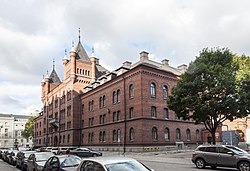
Gamla stan, until 1980 officially Staden mellan broarna, is the old town of Stockholm, Sweden. Gamla stan consists primarily of the island Stadsholmen. Officially, but not colloquially, Gamla stan includes the surrounding islets Riddarholmen, Helgeandsholmen and Strömsborg. It has a population of approximately 3,000.

A carriage is a two- or four-wheeled horse-drawn vehicle for passengers. Second-hand private carriages were common public transport, the equivalent of modern cars used as taxis. Carriage suspensions are by leather strapping or, on those made in recent centuries, steel springs. Two-wheeled carriages are usually owner-driven.

Stockholm Palace, or the Royal Palace, is the official residence and major royal palace of the Swedish monarch. Stockholm Palace is in Stadsholmen, in Gamla stan in the capital, Stockholm. It neighbours the Riksdag building. The offices of the King, the other members of the Swedish royal family, and the Royal Court of Sweden are here. The palace is used for representative purposes by the King whilst performing his duties as the head of state.
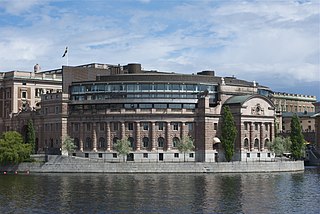
Helgeandsholmen is a small island in central Stockholm, Sweden. It is located north of Stadsholmen, and east of Strömsborg, with which, together with Riddarholmen, it forms Gamla stan, the old town of Stockholm. Helgeandsholmen contains the Riksdag Building and the Museum of Medieval Stockholm, and is connected to neighbouring islands through three bridges: Riksbron, Stallbron, and Norrbro. Despite the small size, it's very important as it contains the parliment building, where the Prime Minister is.

Drottningholm Palace, or Drottningholm, one of Sweden's royal palaces, situated near Sweden's capital Stockholm, is the private residence of the Swedish royal family.
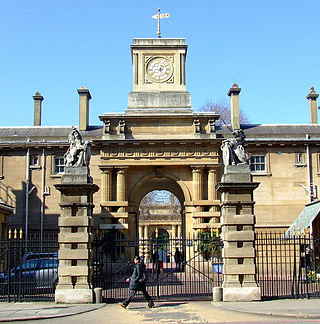
The Royal Mews is a mews, or collection of equestrian stables, of the British royal family. In London these stables and stable-hands' quarters have occupied two main sites in turn, being located at first on the north side of Charing Cross, and then within the grounds of Buckingham Palace.

The National Library of Sweden is Sweden's national library. It collects and preserves all domestic printed and audio-visual materials in Swedish, as well as content with Swedish association published abroad. Being a research library, it also has major collections of literature in other languages.
Master of the Horse is an official position in several European nations. It was more common when most countries in Europe were monarchies, and is of varying prominence today.

A mews is a row or courtyard of stables and carriage houses with living quarters above them, built behind large city houses before motor vehicles replaced horses in the early twentieth century. Mews are usually located in desirable residential areas, having been built to cater for the horses, coachmen and stable-servants of prosperous residents.
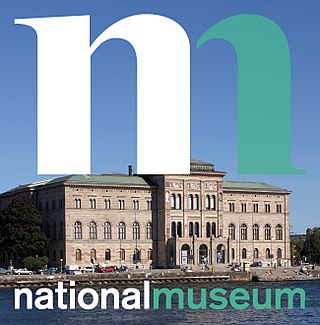
Nationalmuseum is the national gallery of Sweden, located on the peninsula Blasieholmen, in central Stockholm.

The Daimler DS420, also known as the Daimler Limousine, is a limousine made by the Daimler Company between 1968 and 1992. The car was designed for official use and it was popular with chauffeur services, hoteliers and undertakers. It was used as an official state car in many countries. No other limousine model has been delivered to more reigning monarchs than the DS420, and the car is still used by the royal houses of the United Kingdom, Sweden, Denmark, and Luxembourg.

Hooper & Co. was a British coachbuilding business for many years based in Westminster London. From 1805 to 1959 it was a notably successful maker, to special order, of luxury carriages, both horse-drawn and motor-powered.
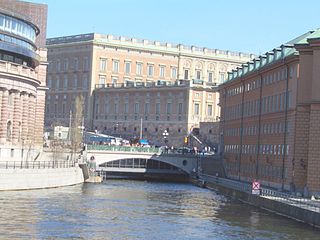
Stallbron is an arch bridge located in Gamla stan, the old town in central Stockholm, Sweden. Stretching some 20 meters over Stallkanalen it connects Riksgatan passing through the Parliament Building on Helgeandsholmen to the square Mynttorget on Stadsholmen from where Västerlånggatan extends it further south.

Riksbron is an arch bridge in central Stockholm, Sweden, leading from Drottninggatan on Norrmalm 44 metres (144 ft) over to Riksgatan on Helgeandsholmen.

Södra Bankohuset or Gamla Riksbanken is a building in Gamla stan, the old town of Stockholm, Sweden, together with Norra Bankohuset the location of the Bank of Sweden until 1906. Since December 2018, the building is housing Embark Studios, a Stockholm-based games studio.

Windsor Grey is a moniker for the grey horses used by the British monarchy to pull carriages and state coaches in ceremonial processions such as those for coronations, royal weddings, Trooping the Colour, and the opening of Parliament. They are named for Windsor Castle where they were originally stabled, though today they live at the Royal Mews near Buckingham Palace.
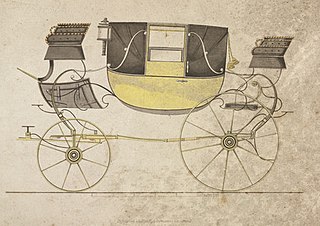
In coachbuilding, a landau is a four-wheeled carriage with a roof that can be let down. It was a luxury carriage. The low shell of the landau provides maximal visibility of the occupants and their clothing, a feature that makes a landau still a popular choice for Lord Mayors in the United Kingdom on ceremonial occasions.

The Royal Stables is the mews of the Danish monarchy which provides the ceremonial transport for the Danish royal family during state events and festive occasions. The Royal Stables are located at Christiansborg Palace on the island of Slotsholmen in central Copenhagen, Denmark. In 1789, the number of horses reached a peak with 270 horses stabled. Nowadays, there are about 20 horses in the Royal Stables.

The state and royal cars of the United Kingdom are kept at the Royal Mews, Buckingham Palace, where a wide range of state road vehicles are kept and maintained. The vehicles also are stored at other royal residences as required.
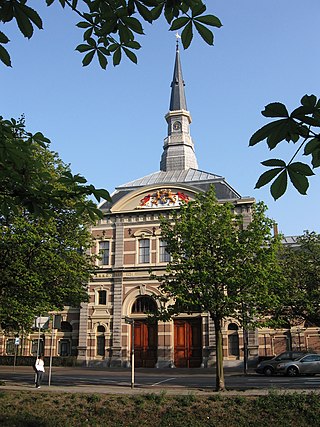
The Royal Stables is a collection of equestrian stables of the Dutch royal family, the House of Orange-Nassau. It is a Rijksmonumental building that is part of the royal palace grounds located in the city center of The Hague in the Netherlands. The Noordeinde Palace and the Palace Gardens are also part of this same palace complex. The Noordeinde Palace and its grounds are the official workplace of the Dutch King Willem-Alexander.


